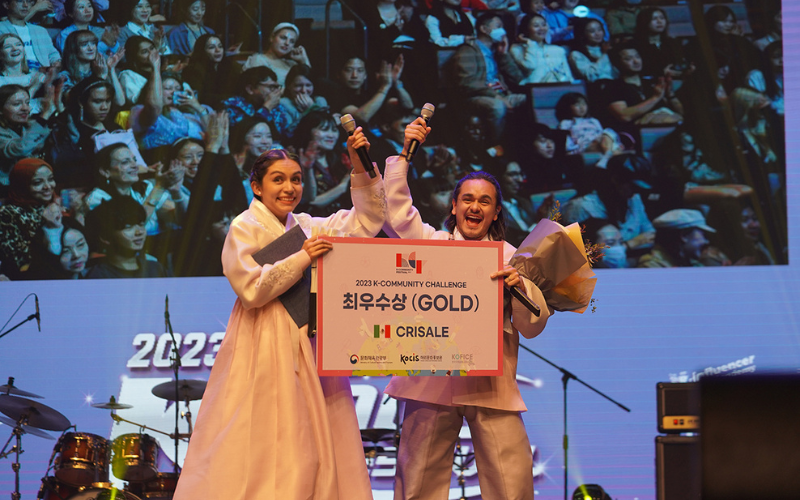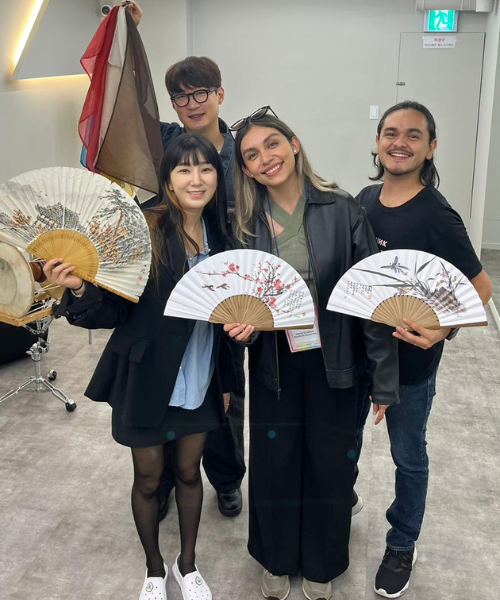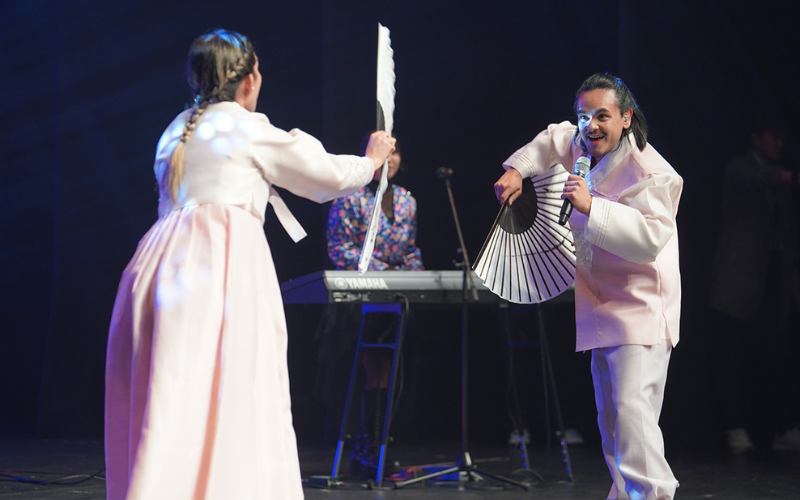- 한국어
- English
- 日本語
- 中文
- العربية
- Español
- Français
- Deutsch
- Pусский
- Tiếng Việt
- Indonesian
By Honorary Reporter Laura Lopez Velazquez from Mexico
Photos = Crisale
Since 2019, the Ministry of Culture, Sports and Tourism and Korean Foundation for International Cultural Exchange (KOFICE) have held the annual K-Community Festival to promote cultural exchange at the global level.
Since 2020, this event has also featured the K-Community Challenge, a contest for promoting traditional Korean arts through a video that incorporates cultural elements from Korea and the creator's country.
In last year's competition, the Mexican duo Crisale won the Joseon pop category, which combines gugak (traditional music) with contemporary pop. Its two members are Cristina Bautista, a singing teacher and musical theater actor, and Alejandro Membrillo, a journalist and artist.
On Nov. 4 last year, I saw an amazing live performance by the duo at the K-Wave Festival held at the National Theater of Korea in Seoul and decided to interview both members.
The following are excerpts from the Jan. 13 interview via Google Meets.

Crisale members Cristina Bautista and Alejandro Membrillo on Nov. 4, 2023, receive the K-Community Challenge's grand prize at the National Theater of Korea in Seoul.
Why did you enter the K-Community Challenge with Joseon pop as your genre?
Alejandro: What motivates us most as a couple and artists is doing things together and our artistic sensibilities are similar. In addition to visiting Korea, we were thrilled that the winners got to perform at the National Theater of Korea. On our choice of genre, we decided that Joseon pop was ideal for us, so we studied its traditional, cultural and artistic parts.
Describe the process for creating your video.
Cristina: First, we carefully studied the lyrics of the song, wrote how we understood it phonetically and spent a day recording it. Since we only knew certain words in Korean, we were afraid of the language because we wanted to create a performance sounding as dignified as possible. While recording, we imagined what to represent in each part of the song and created a storyboard with our ideas. We also thought of renting a Hanbok but couldn't find it, so we had to wear normal clothing and added traditional hairstyles like those from the Joseon Dynasty (1392-1910).
Alejandro: Finally, we looked for a quiet place to record the scenes and add a humorous touch, but also took care to respect the original essence of the song. Once all the elements were completed, the audiovisual production, assembly and editing were simple. We spent three days on the video's production.
What cultural elements of Mexico did you incorporate in your video?
Alejandro: We knew that the song was about a pumpkin that broke and spilled treasure, so we associated it with the Mexican pinata. With that as the starting point, we wanted to develop a story combining both cultures. Later, we added the masks of the Mexican folk dance Danza de los viejitos (dance of the little old men), as we found that similar masks are also used in Korea to represent laypeople.
How was it working with the K-pop girl group AUX at the K-Community Festival?
Cristina: Before going to Korea, we rehearsed a lot. We learned the lyrics of the song to replicate it because we were going to perform live in front of a Korean audience. The day before the event in Seoul, we met the singing teacher and our mentors, AUX members Seo Jin-sil and Lee Woo-sung, decided what to do on stage and learned the full version of the song to present it. We rehearsed a lot and performed it well in the end.

Crisale on Nov. 3, 2023, poses for a photo with AUX members Seo Jin-sil and Lee Woo-sung.

Crisale on Nov. 4, 2023, perform at the K-Community Festival held at the National Theater of Korea in Seoul.
Alejandro: Our seven-day trip had us traveling with the winning teams from Nigeria and China. We visited leading tourist sites in Seoul such as Lotte World Tower, Gyeongbokgung Palace, Bukchon Hanok Village and Gwangjang Market.
Cristina: We loved the food especially tteokbokki (spicy rice cake). I had such a good time that I didn't want the trip to end. We interacted beautifully with the people we met.
Any last message for Korea.net readers and K-Community Challenge aspirants?
Both: What started as a fun experience ended up being something very special and unforgettable. This trip was more than we imagined and completely changed us personally and professionally. Win or lose, you gain much deeper knowledge of Korea and its culture. That's why we recommend getting carried away by your passion and participating to have fun, because you never know how far your passion can take you.
jihlee08@korea.kr
*This article is written by a Korea.net Honorary Reporter. Our group of Honorary Reporters are from all around the world, and they share with Korea.net their love and passion for all things Korean.